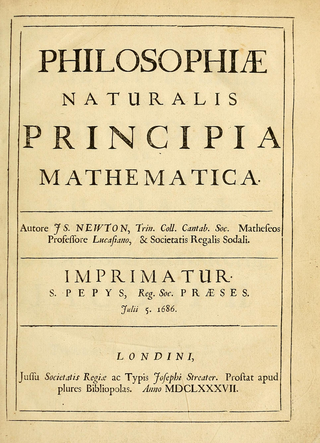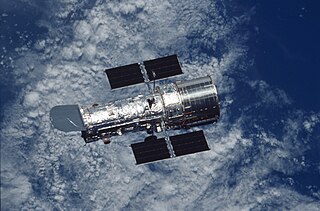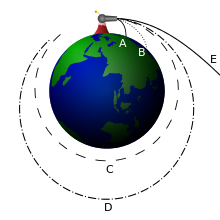Theory
In this experiment from his book (pp. 5–8), [2] Newton visualizes a stone being projected from the top of a high mountain, and that "that there is no air about the earth, or at least that it is endowed with little or no power of resisting".
As a gravitational force acts on the projectile, it will follow a different path depending on its initial velocity.
If the speed is low, it will simply fall back on Earth.
If the speed is the orbital speed at that altitude, it will go on circling around the Earth along a fixed circular orbit "and return to the mountain from which it was projected".
If the speed is higher than the orbital velocity, but not high enough to leave Earth altogether (lower than the escape velocity), it will continue revolving around Earth along an elliptical orbit.
If the speed is very high, it will leave Earth in a parabolic (at exactly escape velocity) or hyperbolic trajectory.

Sir Isaac Newton was an English polymath active as a mathematician, physicist, astronomer, alchemist, theologian, and author who was described in his time as a natural philosopher. He was a key figure in the Scientific Revolution and the Enlightenment that followed. His pioneering book Philosophiæ Naturalis Principia Mathematica, first published in 1687, consolidated many previous results and established classical mechanics. Newton also made seminal contributions to optics, and shares credit with German mathematician Gottfried Wilhelm Leibniz for developing infinitesimal calculus, though he developed calculus years before Leibniz. He is considered one of the greatest and most influential scientists in history.
Inertia is the tendency of objects in motion to stay in motion, and objects at rest to stay at rest, unless a force causes its speed or direction to change. It is one of the fundamental principles in classical physics, and described by Isaac Newton in his first law of motion. It is one of the primary manifestations of mass, one of the core quantitative properties of physical systems. Newton writes:
LAW I. Every object perseveres in its state of rest, or of uniform motion in a right line, except insofar as it is compelled to change that state by forces impressed thereon.
Mechanics is the area of mathematics and physics concerned with the relationships between force, matter, and motion among physical objects. Forces applied to objects result in displacements or changes of an object's position relative to its environment.

Philosophiæ Naturalis Principia Mathematica often referred to as simply the Principia, is a book by Isaac Newton that expounds Newton's laws of motion and his law of universal gravitation. The Principia is written in Latin and comprises three volumes, and was first published on 5 July 1687.
Newton's laws of motion are three laws that describe the relationship between the motion of an object and the forces acting on it. These laws, which provide the basis for Newtonian mechanics, can be paraphrased as follows:
- A body remains at rest, or in motion at a constant speed in a straight line, unless acted upon by a force.
- The net force on a body is equal to the body's acceleration multiplied by its mass or, equivalently, the rate at which the body's momentum changes with time.
- If two bodies exert forces on each other, these forces have the same magnitude but opposite directions.
The following is a timeline of classical mechanics:

Astronautics is the practice of traveling beyond Earth's atmosphere into outer space. Spaceflight is one of its main applications and space science is its overarching field.
Newton's law of universal gravitation says that every particle attracts every other particle in the universe with a force that is proportional to the product of their masses and inversely proportional to the square of the distance between their centers. Separated objects attract and are attracted as if all their mass were concentrated at their centers. The publication of the law has become known as the "first great unification", as it marked the unification of the previously described phenomena of gravity on Earth with known astronomical behaviors.

Method of Fluxions is a mathematical treatise by Sir Isaac Newton which served as the earliest written formulation of modern calculus. The book was completed in 1671 and posthumously published in 1736.
The year 1687 in science and technology involved some significant events.

Absolute space and time is a concept in physics and philosophy about the properties of the universe. In physics, absolute space and time may be a preferred frame.

A space gun, sometimes called a Verne gun because of its appearance in From the Earth to the Moon by Jules Verne, is a method of launching an object into space using a large gun- or cannon-like structure. Space guns could thus potentially provide a method of non-rocket spacelaunch. It has been conjectured that space guns could place satellites into Earth's orbit, and could also launch spacecraft beyond Earth's gravitational pull and into other parts of the Solar System by exceeding Earth's escape velocity of about 11.20 km/s. However, these speeds are too far into the hypersonic range for most practical propulsion systems and also would cause most objects to burn up due to aerodynamic heating or be torn apart by aerodynamic drag. Therefore, a more likely future use of space guns would be to launch objects into Low Earth orbit, at which point attached rockets could be fired or the objects could be "collected" by maneuverable orbiting satellites.

Feynman's Lost Lecture: The Motion of Planets Around the Sun is a book based on a lecture by Richard Feynman. Restoration of the lecture notes and conversion into book form was undertaken by Caltech physicist David L. Goodstein and archivist Judith R. Goodstein.
The System of the World can refer to several things:
De motu corporum in gyrum is the presumed title of a manuscript by Isaac Newton sent to Edmond Halley in November 1684. The manuscript was prompted by a visit from Halley earlier that year when he had questioned Newton about problems then occupying the minds of Halley and his scientific circle in London, including Sir Christopher Wren and Robert Hooke.
The General Scholium is an essay written by Isaac Newton, appended to his work of Philosophiæ Naturalis Principia Mathematica, known as the Principia. It was first published with the second (1713) edition of the Principia and reappeared with some additions and modifications on the third (1726) edition. It is best known for the "Hypotheses non fingo" expression, which Newton used as a response to some of the criticism received after the release of the first edition (1687). In the essay Newton not only counters the natural philosophy of René Descartes and Gottfried Leibniz, but also addresses issues of scientific methodology, theology, and metaphysics.

In classical mechanics, Newton's theorem of revolving orbits identifies the type of central force needed to multiply the angular speed of a particle by a factor k without affecting its radial motion. Newton applied his theorem to understanding the overall rotation of orbits that is observed for the Moon and planets. The term "radial motion" signifies the motion towards or away from the center of force, whereas the angular motion is perpendicular to the radial motion.
In physics and in the mathematics of plane curves, a Cotes's spiral is one of a family of spirals classified by Roger Cotes.
In 1686, when the first book of Newton's Principia was presented to the Royal Society, Robert Hooke accused Newton of plagiarism by claiming that he had taken from him the "notion" of "the rule of the decrease of Gravity, being reciprocally as the squares of the distances from the Center". At the same time Hooke agreed that "the Demonstration of the Curves generated thereby" was wholly Newton's.
This page is based on this
Wikipedia article Text is available under the
CC BY-SA 4.0 license; additional terms may apply.
Images, videos and audio are available under their respective licenses.









